The Nile River is the longest river in Africa. It is over 4,000 miles long and branches into smaller rivers for miles. In these rivers and surrounding the area are wild snakes. The snakes all have different habitats, diets, experiences, and appearances.
Snakes thrive near the Nile River because of the large fish, toad, and bird population. There are plenty of trees to provide shade, and it is a quiet area with lots of crevices to hide in.
Regardless of why you want to know, it is a good idea to familiarize yourself with common snakes near the Nile River. Are you ready to learn more information about these venomous and non-venomous Nile River snakes? Keep reading to discover interesting facts about ten snakes found in the Nile River.
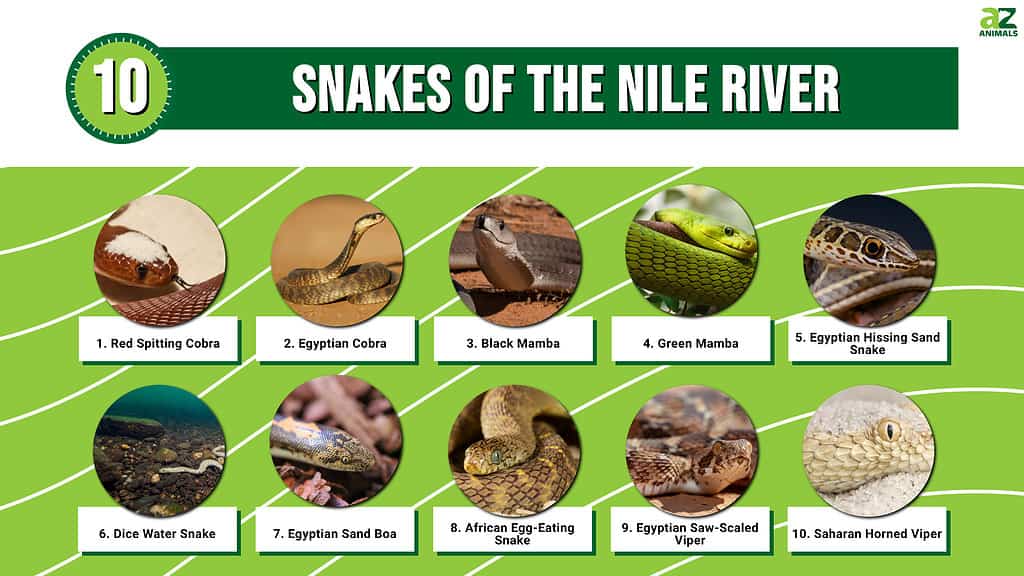
1. Red Spitting Cobra
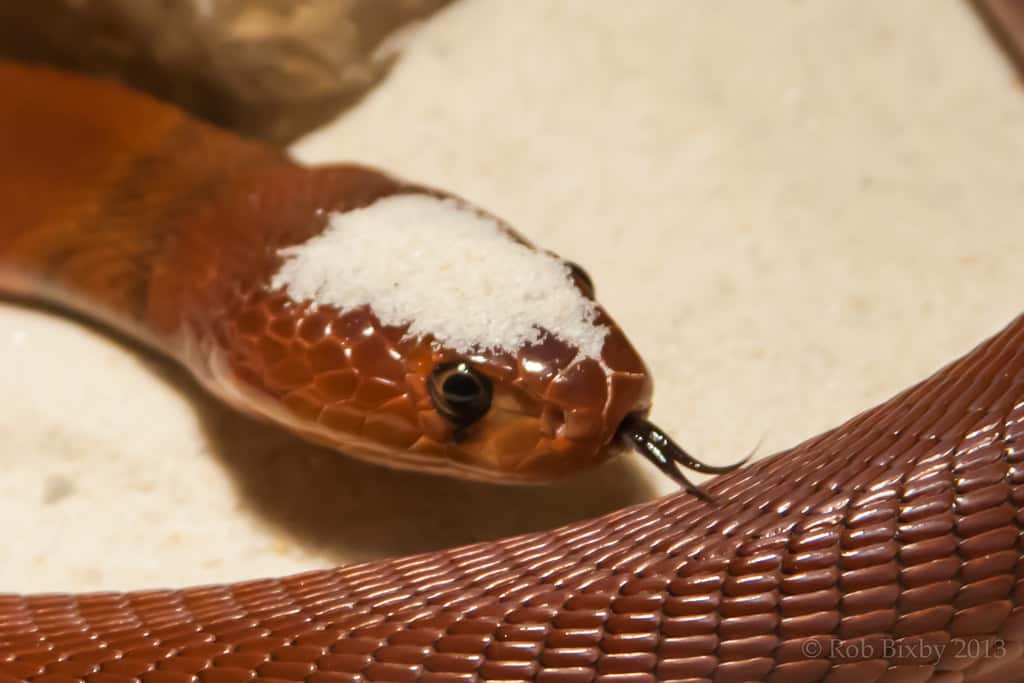
The red spitting cobra is native to the continent of
Africa
.
©
Don’t worry; red spitting cobras probably won’t spit in your direction! They are docile snakes and won’t attack unless they feel threatened. Human fatalities are rare, but scientists think that red spitting cobras evolved because of early humans and their threats. These salmon snakes are bright with a black throat band and teardrop markings throughout their scales. They reside near the Nile River in Southern Egypt and live in dry deserts.
Red spitting cobras eat toads, frogs, chickens, mice, and other small snakes. Like most snakes, they are polygynandrous and don’t provide parental care to baby snakes. When adults, these snakes range in length from 2.3 ft to 3.9 ft.
2. Egyptian Cobra
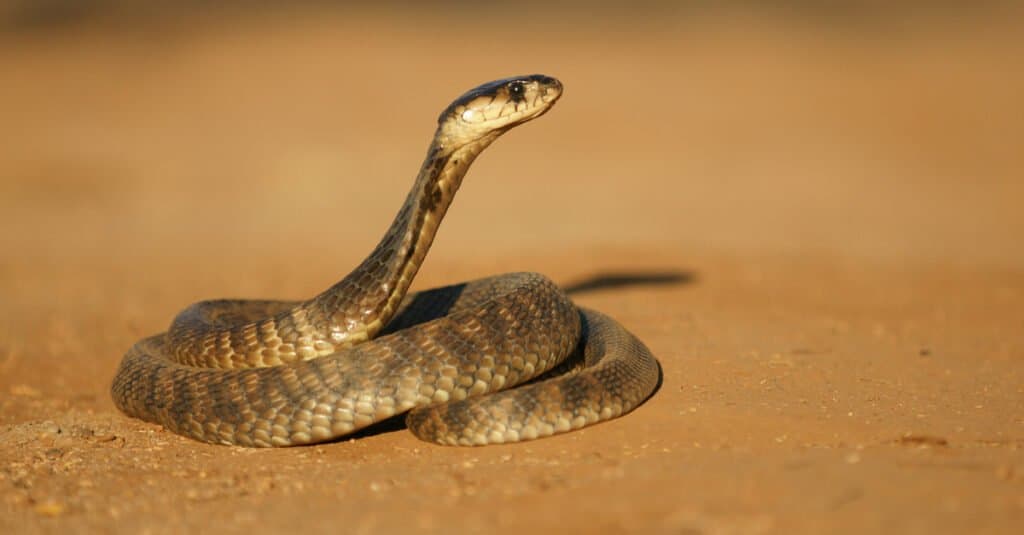
Egyptian cobras are among the largest snakes in Africa.
©Julian W/Shutterstock.com
Egyptian cobras are among the most venomous snakes in the world but are only naturally found in Africa. Unless you have a friend with a pet cobra, it is unlikely you will see one outside of Africa, near the Nile River. It grows between 1-2 meters long and has an average lifespan of 20 years!
The Egyptian cobra has a stout and thick face and a long body and tail. When it is scared or feels threatened, the cobra will move upright, expand its menacing hood, hiss, and strike! This snake rarely goes near humans unless it is hunting for domestic chickens or rodents. A big part of its diet consists of small reptiles like lizards.
3. Black Mamba
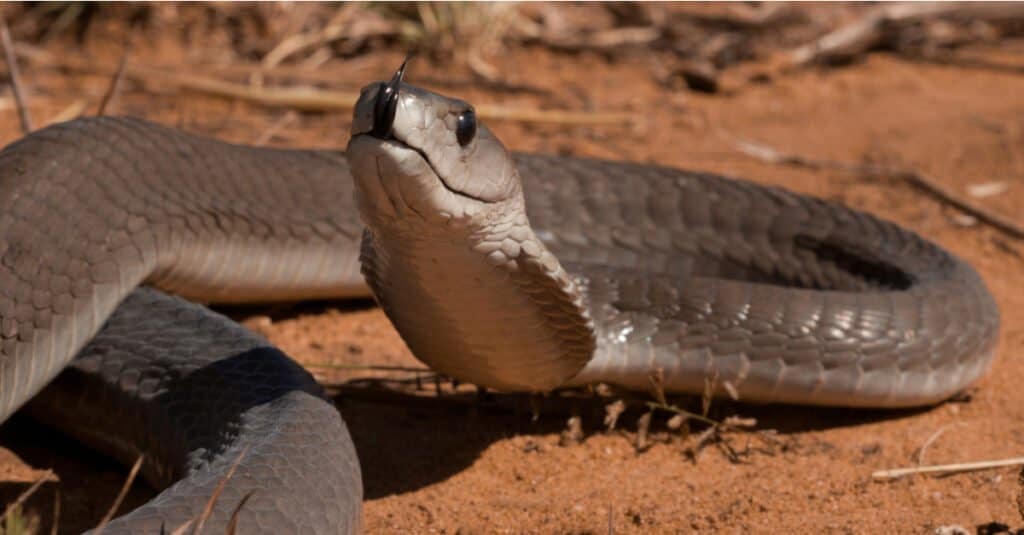
Black mambas have coffin-shaped heads, large eyes, and long tails.
©131346563/Shutterstock.com
Black mambas are another snake species commonly found in the desert regions of Egypt near the Nile River. They are one of the world’s deadliest snakes with their toxic venom. Not only do they have toxic venom, but these snakes are fast and not afraid to attack first!
Interestingly, black mambas are not black but a deep brown and olive color. Instead, the inside of their mouths is dark black, which they show as a warning. Black mambas are also long snakes. Some have been recorded to grow as long as 14 feet.
4. Green Mamba
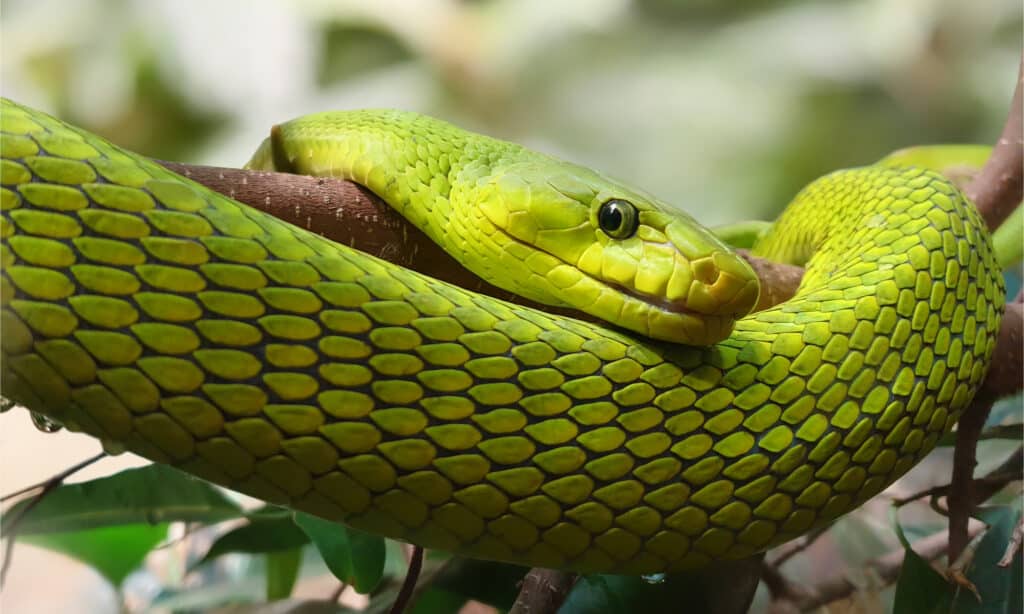
Eastern green mambas are the smallest of the four extant species of mambas.
©Henner Damke/Shutterstock.com
Don’t let their size and brilliant colors fool you; eastern green mambas are venomous and highly deadly snakes. They live alone and prefer not to mingle in large groups since they are territorial and protective. Most live in the Eastern and Southern regions of Africa, but some do live in the trees near the Nile River.
Unlike other snakes, they prefer living by the coast. In other words, it is not a good idea to touch trees and bushes if you are visiting the Nile River as you might bump into a green mamba. Most eastern green mambas feast on vulnerable bird eggs and nests, and even bats.
5. Egyptian Hissing Sand Snake
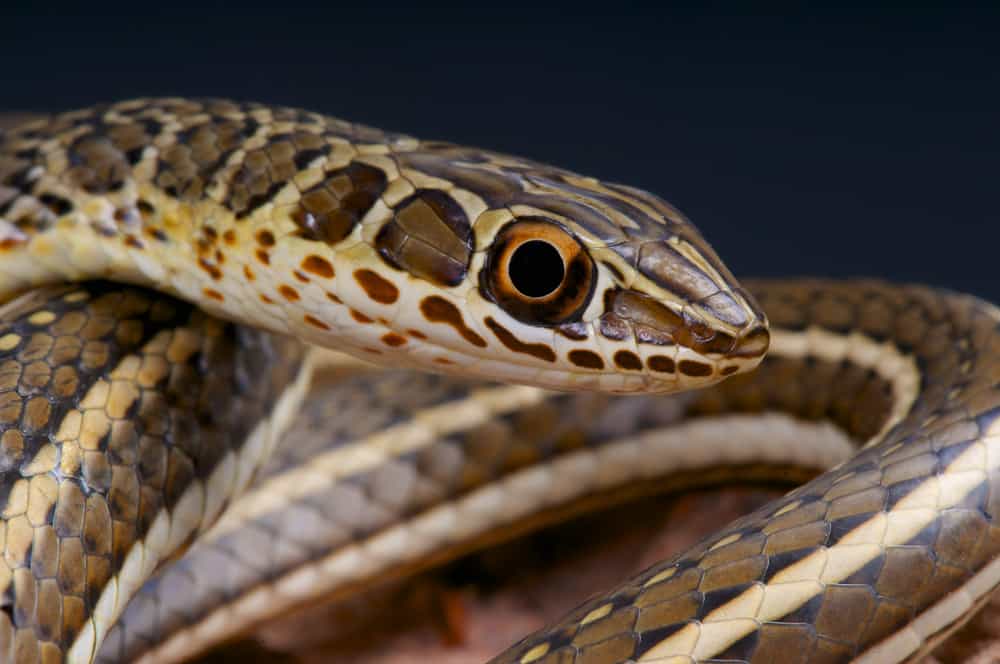
Hissing sand snakes are small and thin climbing snakes.
©reptiles4all/Shutterstock.com
Hissing sand snakes are small and thin, but they are quick! They hunt by the Nile River and have large venom glands. Although hissing sand snakes can live in hot desert regions, they prefer sleeping and feeding in semi-desert regions and on a wetland.
Hissing sand snakes also come in many colors, including brown, orange, red, black, and yellow in different shades. They blend into the sand and dirt in the ground but are also excellent climbers.
6. Dice Water Snake
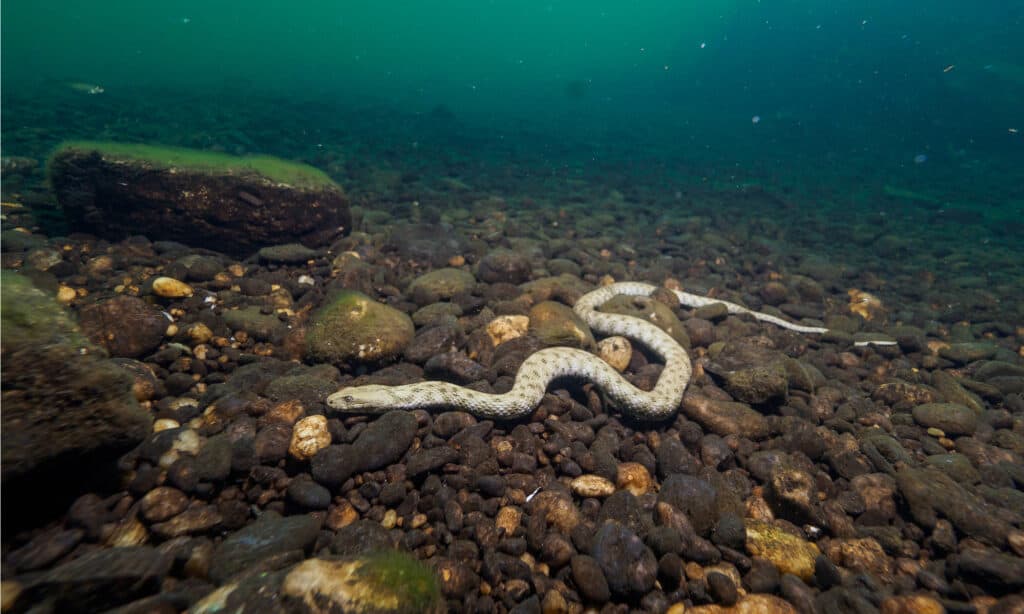
Dice snakes are non-venomous snakes found in the Nile River and parts of Eurasia.
©benny337/Shutterstock.com
Dice water snakes are also known as dice snakes and live in the water. They range in colors depending on where they live but typically camouflage well while swimming underwater. Dice water snakes sometimes also have bright yellow or orange bellies.
There is a size difference between males and females. Female dice water snakes are larger than males, likely because they carry and lay eggs. Most dice water snakes consume small fish, tadpoles, and frogs. Since they are non-venomous, dice water snakes will ‘play dead’ when they feel threatened by a larger predator or secrete an awful smell in the area.
7. Egyptian Sand Boa
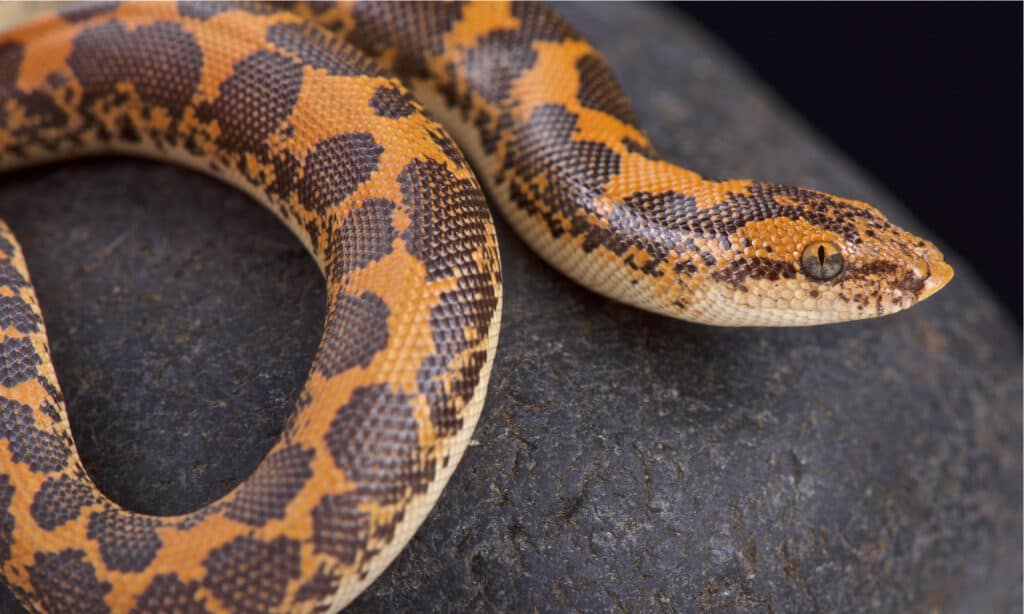
Egyptian sand boas mature at 2-3 years old.
©reptiles4all/Shutterstock.com
Another snake you can find in and near the Nile River is the Egyptian sand boa. There are still a lot of information experts do not know about this snake because it is hard to study in the wild. In captivity, an Egyptian sand boa lives up to 20 years.
While the majority of Egyptian sand boas are in Egypt, you can also find them in Tanzania, Southwest Somalia, and Kenya. Fun fact, these snakes live 80% of their lives buried in the sand, which is why we call them ‘sand boas.’ Their heads look like shovels, and they use them to dig through the sand to burrow into their homes.
8. African Egg-Eating Snake
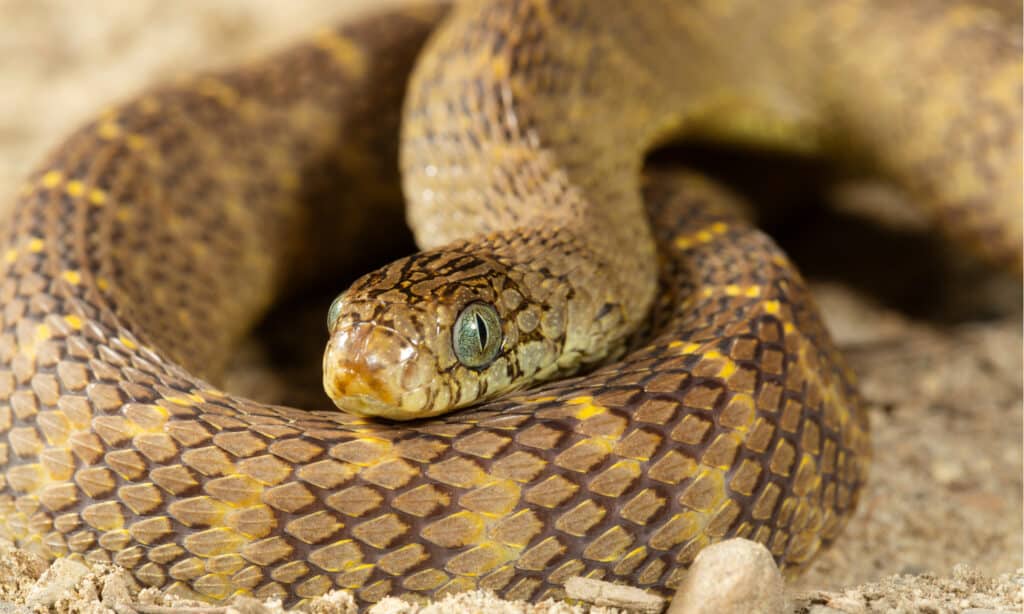
African egg-eating snakes are endemic to Africa.
©Joe McDonald/Shutterstock.com
Being face to face with a large and thick snake can be scary, especially by the Nile River. However, it should bring you relief to know that the African egg-eating snake is native to Africa, and it is generally harmless. This snake rarely attacks and prefers to stay alone. Actually, it frequently steals eggs from nests.
African egg-eating snakes are also popular pets in the world. Some pet owners mainly feed their egg-eating snakes finch eggs. Unlike other snake species, the African egg-eating snake is happy living with the same and opposite sex. Also, watching this snake eat is interesting since it can completely swallow an egg.
9. Egyptian Saw-Scaled Viper
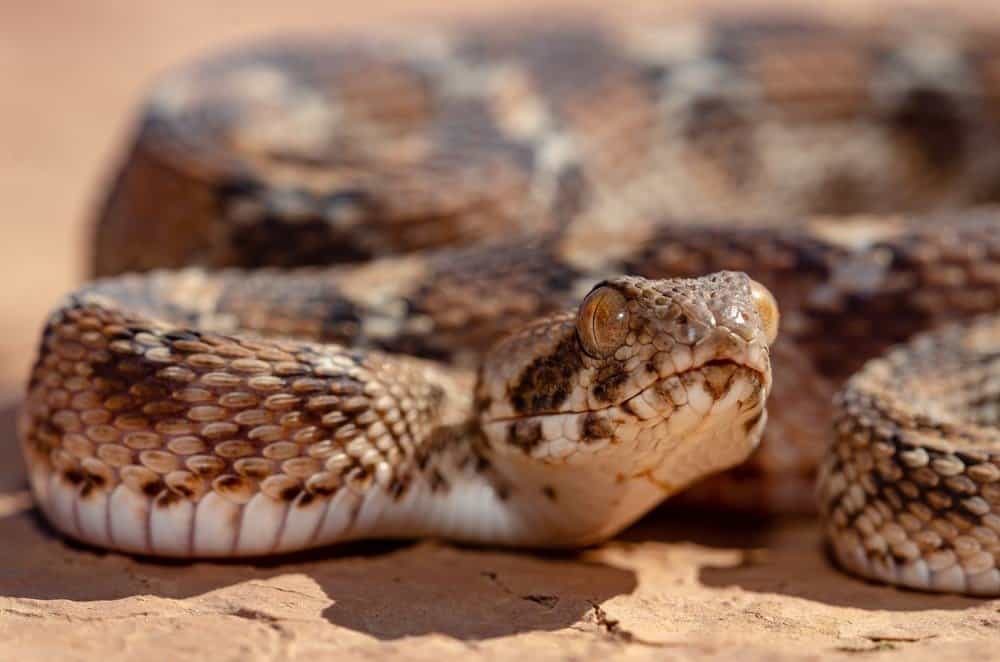
There are eight species of saw-scaled vipers, and they live in similar regions.
©Luis Montero de Espinosa/Shutterstock.com
Egyptian saw-scaled vipers are small and scary-looking snakes. They have large eyes, a wide head, and a small/short tail. These snakes prefer living in rocky deserts, especially near a water source, like the Nile River. Their coloration depends on the region, but it is usually a mix of deep red, brown, and yellow. Using their unique colors, the Egyptian saw-scaled vipers blend into their surroundings.
Like other desert snakes, the Egyptian saw-scaled vipers use their flat heads to burrow their bodies into the sand without covering their eyes. They spend most of their days underground. When they feel threatened, they are not afraid to attack and will make loud noises with their scales. These snakes are known for attacking ankles and can chase people.
10. Saharan Horned Viper
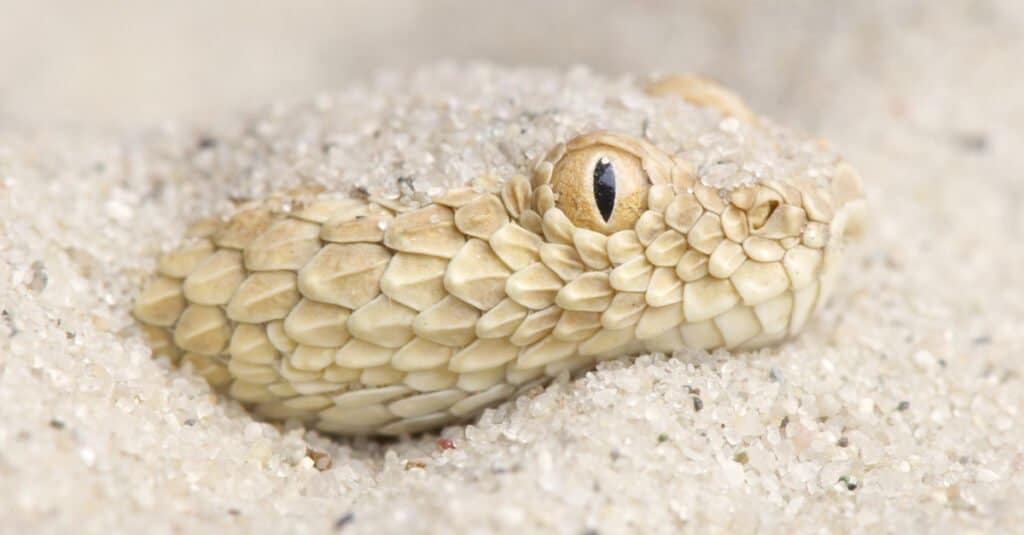
Another name for the Saharan horned viper is the desert horned viper.
©reptiles4all/Shutterstock.com
Some people also call Saharan horned vipers “desert horned vipers.” These beautiful snakes burrow themselves into the sand and blend in well. It is easy to recognize because of their two ‘horns’ at the top of their heads. The color of the snakes is also eye-catching since they are light yellow with pale pink and gray.
The lifespan for Saharan horned vipers is 14-18 years. These vipers prefer wet sands that are soft and easy to burrow into. They are quiet hunters and wait for unsuspecting prey to make contact first while hiding under the sand. When their prey is close enough, the Saharan horned vipers strike quickly.
Summary of 10 Snakes of the Nile River
| Rank | Snake |
|---|---|
| 1 | Red Spitting Cobra |
| 2 | Egyptian Cobra |
| 3 | Black Mamba |
| 4 | Green Mamba |
| 5 | Egyptian Hissing Sand Snake |
| 6 | Dice Water Snake |
| 7 | Egyptian Sand Boa |
| 8 | African Egg-Eating Snake |
| 9 | Egyptian Saw-Scaled Viper |
| 10 | Saharan Horned Viper |
The photo featured at the top of this post is © Heiko Kiera/Shutterstock.com
Discover the "Monster" Snake 5X Bigger than an Anaconda
Every day A-Z Animals sends out some of the most incredible facts in the world from our free newsletter. Want to discover the 10 most beautiful snakes in the world, a "snake island" where you're never more than 3 feet from danger, or a "monster" snake 5X larger than an anaconda? Then sign up right now and you'll start receiving our daily newsletter absolutely free.
Thank you for reading! Have some feedback for us? Contact the AZ Animals editorial team.






